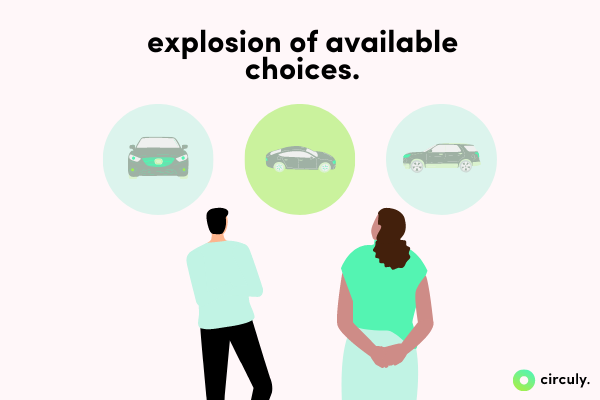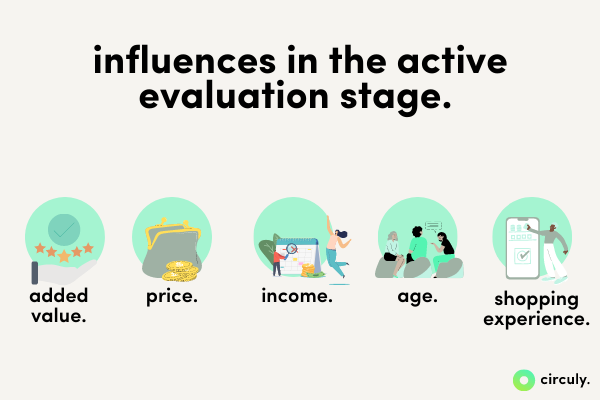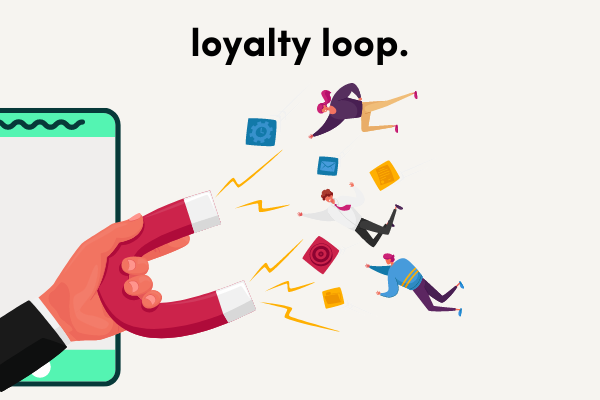The goal of marketing is to reach consumers at the moment that most influence their decisions. These moments are called touchpoints.

For a long time, these touchpoints have been explained through the metaphor of a funnel. Consumers start their purchase journey with an initial set of potential brands in mind and methodically reduce the number of brands as they move along the funnel until they are at the very end of the funnel, which is the moment they make a purchase.

The funnel typically ignores key buying factors resulting from the explosion of product choices and the fact that consumers now are well-informed and actively seek information before making a purchase decision.

Due to the lack of sophistication of the funnel journey, McKinsey and Co. explored a new alternative to the funnel to help marketers navigate an environment that is not linear in nature. They called this the consumer decision journey.
We've extended the original consumer decision journey to a subscriber decision journey or a consumer decision journey for subscription products to understand how consumers make decisions for subscription products.
By doing that, we aim to highlight what goes into consideration when consumers explore a market in which they can choose from either buying a product or subscribing to a product and preferring one more than the other.

Initial Consideration set
As defined by McKinsey Consumer-Decision Journey - the consumer considers an initial set of brands based on brand perceptions and exposure to recent touchpoints.

Extended to product subscriptions - for subscription products to make the initial consideration set, the target audience needs to be aware of two things:
- The possibility to subscribe to a product instead of buying one
- The existence of your brand/company
Is all hope lost if your target customer isn't aware of your brands' existence?
Simple answer - No! There is still hope.
According to the consumer decision journey, even if consumers do not know about your brand when considering an initial set of brands to evaluate, they can add it to the list later, provided you influence this stage through marketing touchpoints.
Therefore, the no. of brands that move from initial consideration to active evaluation may actually expand as consumers seek more information.
Active evaluation
As defined by McKinsey's Consumer-Decision Journey - consumers add or subtract brands as they evaluate what they want.

Extended to product subscriptions - in this stage, your target customer may not necessarily eliminate one-off buying altogether and instead consider renting. This is especially the case if they are new to the concept of subscribing and haven't experienced a product subscription yet. Therefore to make it past the consideration stage, two things are important.
- Your value proposition comes across nicely through influential marketing channels.
- When comparing different options, your brand makes the cut and meets the expectation of providing a decent customer journey.
In this stage, they will compare different subscription companies and compare subscribing to buying. The decision will be based on and influenced by a no. of things.

- Added value (extra value added by subscriptions compared to one-off purchase) - added value can consist of extra services (free detergent with washing machine), extra convenience (home delivery - especially attractive to consumers with time constraints), reduction in transaction costs (not wasting time in choosing between 200 products and comparing them), access to the latest model, flexibility to upgrade/downgrade, or lower environmental impact.
- Price (subscription price vs. one-off transaction) - subscriptions that save money will attract more customers. Expensive subscriptions can be attractive if the added value is visible to the customer and higher.
- Income of the consumer - consumers with limited income view subscriptions as a gateway to acquiring products that they otherwise couldn't. Interestingly enough, according to a study by ING Economics, subscriptions are also popular among consumers with high incomes.
- Age of the consumer - younger consumer groups are more accepting of subscriptions than older age groups.
- Your shopping experience - your target audience may explore your website while evaluating brands in their initial consideration set and form perceptions based on the experience gained. At this stage if they form a positive experience (through the information you provide and the way your customer experience is designed) they will not only consider your brand for the next stage (that is purchase) but will also form an overall good perception of renting a product in place of buying one. But instead, if they form a negative experience, then your brand will not make it past this stage, but the negative experience can also influence how the prospect view "subscribing/renting" in general.
Bottom line: The user journey should be the focal point while you design your shopping experience, and it definitely needs to be at par with what the customers are already used to, that is, fast, seamless and quick shopping experience.
Moment of purchase
As defined by McKinsey's Consumer-Decision Journey - ultimately, the consumer selects a brand at the moment of purchase.
Extended to product subscriptions - The online shopping experience plays an important role at this stage. The product acquisition journey could be a making or breaking point for your brand. Many digital eCommerce companies have nailed the product acquisition process, and as a result, consumers have become accustomed to a fast, seamless shopping experience. Account creation, lengthy checkout, form inquiries are a no-go for most consumers out there.
Post-purchase experience
As defined by McKinsey Consumer-Decision Journey - after purchasing a product or service, the consumer builds expectations based on experience to inform the next decision journey.

Extended to product subscriptions - When it comes to experiencing a subscription product, this is where the supplier can shine and create a lasting impact. During the post-purchase experience process, it is crucial for the supplier to make sure that the consumer doesn't churn due to operational inaccuracies, lack of knowledge, lack of use and other such reasons specific to the type of product you have and the industry you are in.
The post-purchase experience comprises of the following:
- Post-purchase communication
- Post-purchase customer support
- Post-purchase return experience
Post-purchase communication
Staying on top of transactional communication
Av average customer is subscribed to 5-10 things at the same time, and given all the expenses that are on the credit card in a given month, it may be difficult for your customer to recall the company/product associated with each charge. To avoid any information lags, it's crucial that your transactional communication process (such as payment updates, monthly billing, invoicing, reminder emails etc) is bulletproof and automated.
The
Educational communication
Getting up to speed with transactional communication can be done and automated via a subscription management software (like circuly). Your customers expect such emails, but most companies tend to overlook the importance of educational emails. Answer the question, "how can you make sure that your customers use your product, know how to use it and can make the best use of it?".
Here are some examples based on specific product subscriptions:
- Bikes - send an email to your customer about biking routes in their nearby area and tell them how they can use a phone holder (that you also sell) to navigate the way.
- Baby strollers - is it rainy season again? How about writing an email to your customer about the best ways to dry a stroller fast and pitch them a rain cover for the stroller (that you sell).
- Furniture - how about some inspiration about styling the piece of furniture they are renting from you.
In some cases, you can even create up-sell and cross-sell opportunities for your business.
Post-purchase customer support
This is something many brands have, but don't publicise. Your customer support exists to solve the technical problems of the customer. And since your offer to your customer is a product, the support that you provide will mostly revolve around the product experience.
Product experience includes how your customer experiences the product and makes use of it. Since subscription products are tangible, chances are they may break down. Typical scenarios include:
- Product breakdown - possibility to quickly swap a product
- Downgrade/upgrade - Netflix allows its customers to upgrade or downgrade their subscription easily. Consumers of subscription products expect the same from physical product subscriptions.
- Collecting additional payment - the customer may not be reluctant to pay additional charges for things like damages, speeding tickets etc. but may not appreciate the hassle of doing so with his own efforts. Consumers appreciate anything that reduces effort on their part.
- Product repair - the customer, may require a product repair to continue using the product. Since customers don't have permission to repair subscription products on their own, they require immediate repair assistance in case a product breaks down.
- Payment failure - expired credit cards, unexpected charges on the card etc. Most consumers want the possibility to solve a problem so that they can continue using the product they are subscribed to.
Post-purchase return experience
After the subscription period is over, the customer returns the product back to the vendor.
This step typically doesn't exist for one-off purchase products but is important for subscription products. Even though there is the possibility of buying the product at the end of the subscription period or extending the subscription duration, it is typically a reasonable assumption that all businesses should make is that their products will come back.
How is your product return experience? How are return requests processed? How do your customers inform you that they want to return a product?
It is important to note that if your customers return your product, this is not a bad thing as there is always the possibility that they will subscribe to your product again when they need it and might even recommend it to someone (given they had a positive experience with your brand and your product).
Loyalty loop
As defined by McKinsey's Consumer-Decision Journey - the customer's opinion for subsequent purchases is often shaped through the post-purchase experience. Many brands have after-sales loyalty programs set in place to encourage repeat purchases, but according to the consumer decision journey, not all consumers have the same loyalty to a brand. There are active loyalists and then there are passive loyalists. Passive loyalists tend to stick to a brand out of laziness and confusion caused by the vast plethora of choices. As you can guess, passive loyalists are open to messages from competitors who give them a reason to switch.

Extended to product subscriptions - anyone who is not yet familiar with the concept of renting in place of buying and is not an active-hater of the renting business model can be put into the category of a passive loyalist. Given the correct information and value proposition, consumers can easily switch brands and even prefer renting models over buying models.
Making comparisons, showing benefits etc., are all ways to stir a passive loyalist of a competitor brand or competitor business model (buying/one-off purchase) towards your brand and business model.
Conclusion
When talking about the subscriber decision journey, the first step is to understand if your prospect has at least some knowledge about the existence of your brand and the renting business model. Even if someone is an active buyer (or a passive loyalist of buying products), it is possible to stir them away from buying a product to renting one. If this is the case, then your marketing efforts should focus on the initial consideration stage while keeping in mind that the user experience will play an important role when it's time for active evaluation. In this stage, you want your prospect to think that renting a product is as easy as buying a product.
And when you finally have their attention, it's important that you focus on post-purchase experience (how your consumer experiences your product and the renting business model) to encourage repeat purchases and the mindset shift that is needed to grow the subscription industry.
.png)
%20(25).png)
%20(24).png)





.png)





